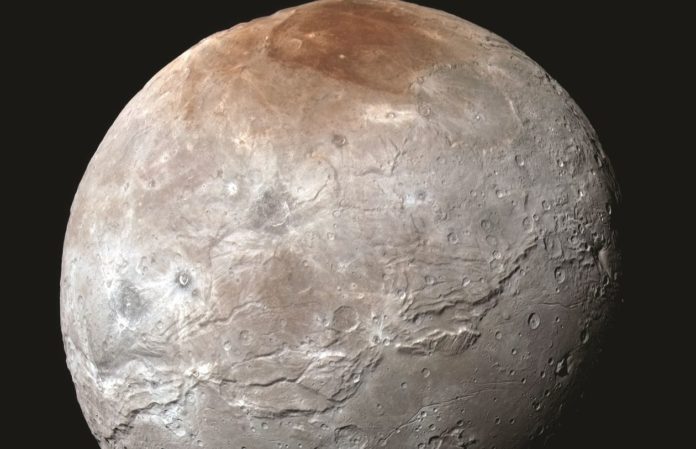Scientists at the Southwest Research Institute used data from NASA’s New Horizons mission, as well as novel laboratory experiments and exospheric modeling, to figure out what the red cap on Pluto’s moon Charon is made of and how it developed.
This is the first time new experimental data has been used to depict Charon’s dynamic methane atmosphere, providing a fascinating peek into the origins of the moon’s red spot, as described in two recent articles.
Before New Horizons, the best Hubble photographs of Pluto revealed only a fuzzy blob of reflected light, according to Randy Gladstone of SwRI, a member of the New Horizons science team.
“In addition to all the fascinating features discovered on Pluto’s surface,” Gladstone said, “the flyby revealed an unusual feature on Charon, a surprising red cap centered on its north pole.”
Soon after the 2015 flyby, New Horizons scientists speculated that UV radiation breaking down methane molecules could produce a reddish “tholin-like” substance at Charon’s pole. These are collected after escaping Pluto and frozen onto the moon’s polar regions during the lengthy winter nights. Tholins are sticky organic leftovers produced by light-driven chemical reactions, specifically the Lyman-alpha ultraviolet glow dispersed by interplanetary hydrogen molecules.
The findings of the new study show “that drastic seasonal surges in Charon’s thin atmosphere as well as light breaking down the condensing methane frost are key to understanding the origins of Charon’s red polar zone,” adds SwRI’s Dr. Ujjwal Raut, lead author of a paper.
“This is one of the most illustrative and stark examples of surface-atmospheric interactions so far observed at a planetary body.”
The researchers measured the composition and color of hydrocarbons formed on Charon’s winter hemisphere as methane freezes beneath the Lyman-alpha glow by simulating Charon surface conditions at SwRI’s new Center for Laboratory Astrophysics and Space Science Experiments (CLASSE). The results were incorporated into a new Charon atmospheric model, which showed methane breaking down into residue on the planet’s north polar region.
“Our team’s novel ‘dynamic photolysis’ experiments provided new limits on the contribution of interplanetary Lyman-alpha to the synthesis of Charon’s red material,” Raut added.
“Our experiment condensed methane in an ultra-high vacuum chamber under exposure to Lyman-alpha photons to replicate with high fidelity the conditions at Charon’s poles.”
In addition, SwRI scientists created a novel computer simulation to mimic Charon’s thin methane atmosphere.
“The model points to ‘explosive’ seasonal pulsations in Charon’s atmosphere due to extreme shifts in conditions over Pluto’s long journey around the Sun,” added Dr. Ben Teolis, lead author.
The team used the results of SwRI’s ultra-realistic experiments to estimate the distribution of complex hydrocarbons produced by methane decomposition under the impact of UV light in an atmospheric model. The model includes polar zones that largely produce ethane, a colorless substance that does not contribute to the reddish hue.
“We think ionizing radiation from the solar wind decomposes the Lyman-alpha-cooked polar frost to synthesize increasingly complex, redder materials responsible for the unique albedo on this enigmatic moon,” Raut remarked. “Ethane is less volatile than methane and stays frozen to Charon’s surface long after spring sunrise. Exposure to the solar wind may convert ethane into persistent reddish surface deposits contributing to Charon’s red cap .”
“The team is set to investigate the role of solar wind in the formation of the red pole,” SwRI’s Dr. Josh Kammer said, noting that NASA’s New Frontier Data Analysis Program has continued to support the project.
Image Credit: SwRI
You were reading: New lab experiment sheds light on the moon’s red spot
